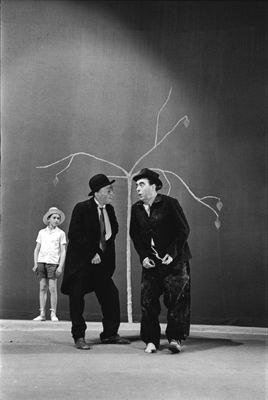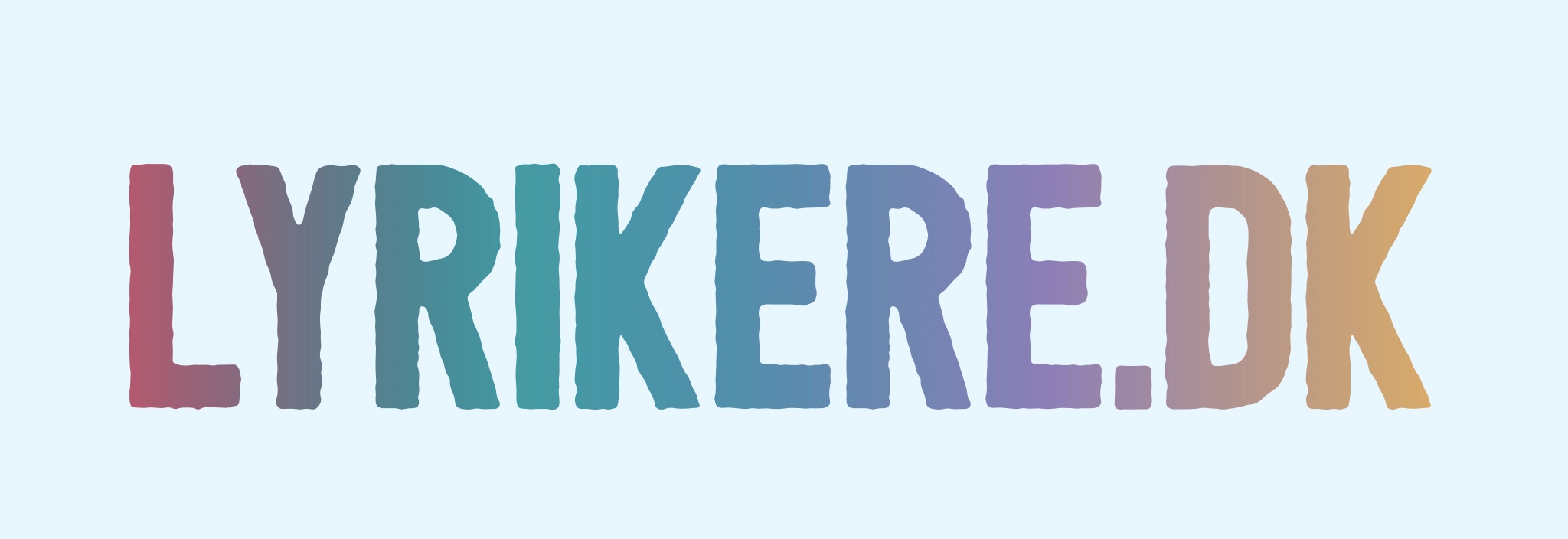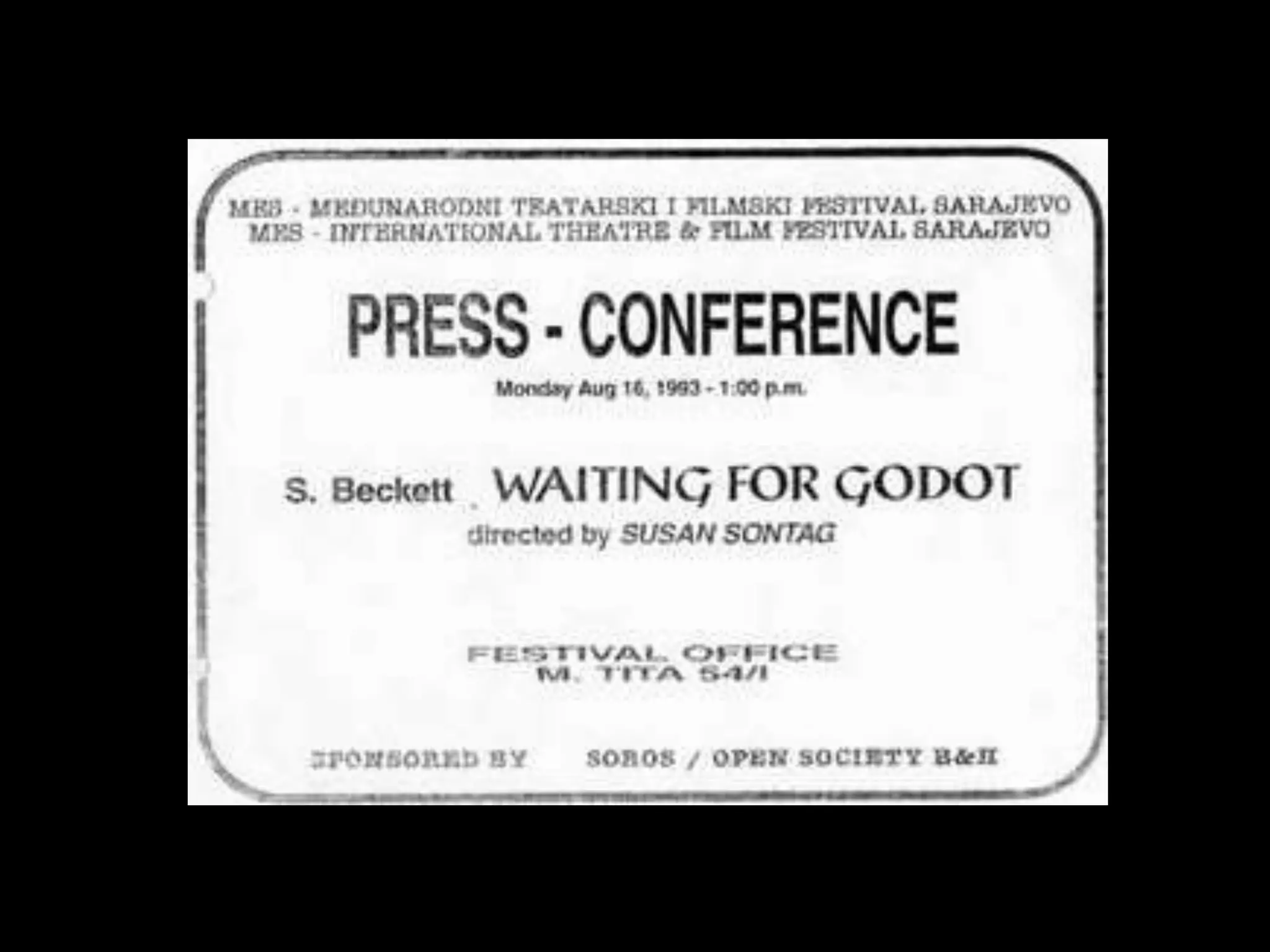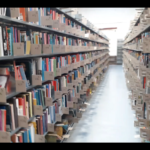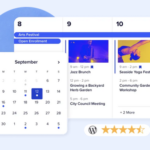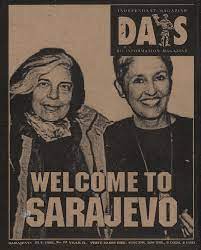 Under krigen på Balkan ml. 1992 og 1995, der nådesløst opdelte et landområde og en hel befolkning, mens omverden nærmest stiltiende så til, kom Susan Sontag til Sarajevo for at besøge sin søn, der var krigsfotograf. Da hun over 14 dage bevidnede krigens konsekvenser, besluttede hun at ville “give en hånd med”. Det gjorde hun så ved at opsætte en ganske særlig version af “Venter på Godot”.
Under krigen på Balkan ml. 1992 og 1995, der nådesløst opdelte et landområde og en hel befolkning, mens omverden nærmest stiltiende så til, kom Susan Sontag til Sarajevo for at besøge sin søn, der var krigsfotograf. Da hun over 14 dage bevidnede krigens konsekvenser, besluttede hun at ville “give en hånd med”. Det gjorde hun så ved at opsætte en ganske særlig version af “Venter på Godot”.
Søg fotos hér
Læs om det hele hér (open access, på engelsk) fra Theater of war – Cultural resistance and Susan Sontag’s staging of Samuel Beckett’s Waiting for Godot in besieged Sarajevo, en master’s thesis af
Fra introduktionen:
The war in Bosnia occurred in the early nineties, between 1992 and 1995. It began when Bosnia gained independence from the former Yugoslavia in 1992 and was brought to an end by the signing of the Dayton Peace Agreement, an international intervention in late 1995. The ultranationalist Bosnian Serb forces (supported by the Serb Yugoslav Army) targeted the Bosnian Muslim and Croat population, resulting in more than 100,000 fatalities of all ethnic backgrounds, tens of thousands of raped women, and more than 2.2 million displaced people. The siege of Sarajevo lasted for 1,425 days.1 This makes it the longest military siege in the history of modern warfare, longer than the 900-day siege of Leningrad in the Second World War. The entire capital was destroyed and its utilities cut off, leaving the city without electricity, heating, and phone lines, and with tap water and food supplies that were basically acquired through humanitarian aid. The civilians could not defend themselves. They were bound to wait while hoping for Western intervention. This siege also stands out for the international media presence, the cultural resistance in the city, and its multicultural nature.
—
Her ses fotos fra Sontags produktion præsenteret under en masters-opgave fra 2014, på engelsk. Og hér selve præsentationen:
—
Fra indledningen til Susan Sontags eget essay i Performing Arts #47 (1994), s 87-105:
WAITING FOR GODOT IN SARAJEVO
Susan Sontag
“Nothing to be done.”
“Nista ne moze da se uradi.”
– opening line of Waiting for Godot by Samuel Beckett
I went to 1993 in to Sarajevo mid-July to stage a production of waiting for Godot not so much because I’d always wanted to direct Beckett’s play (although I had), as because it gave me a practical reason to return to Sarajevo and stay for a month or more. I had spent two weeks there in April, and had come to care intensely about the battered city and what it stands for; some of its citizens had become friends. But I couldn’t again be just a witness: that is, meet and visit, tremble with fear, feel brave, feel depressed, have heartbreaking conversations, grow ever more indignant, lose weight. If I went back, it would be to pitch in and do something.
No longer can a writer consider that the imperative task is to bring the news to the outside world. The news is out. Plenty of excellent foreign journalists (most of them in favor of intervention, as I am) have been reporting the lies and the slaughter since the beginning of the siege, while the decision of the western European powers and the United States not to intervene remains firm, thereby giving the victory to Serb fascism. I was not under the illusion that going to Sarajevo to direct a play would make me useful in the way I could be if I were a doctor or a water systems engineer. It would be a small contribution. But it was the only one of the three things I do-write, make films, and direct in the theatre-which yields something that would exist only in Sarajevo, that would be made and consumed there.
Among the people I’d met in April was a young Sarajevo-born theatre director, Haris Pasovic, who had left the city afte he finished school and made his considerable reputation working mainly in Serbia. When the Serbs started the war in April 1992, Pasovic went abroad, but in the fall, while working on a spectacle called Sarajevo in Antwerp, he decided that he could no longer remain in safe exile, and at the end of the year managed to crawl back past UN patrols and under Serb gunfire into the freezing, besieged city. Pavsovic invited me to see his Grad (“City”) – a collage, with music, of declamations, partly drawn from texts by Constantine Cavafy, Zbigniew Herbert, and Sylvia Plath, using a dozen actors – which he had put together in eight days. Now he was preparing a far more ambitious production, Euripides’Alcestis, after which one of his students (Pasovic teaches at the still-functioning Academy of Drama) would be directing Sophocles’Ajax. Realizing suddenly that I wastalking to a producer as well as to a director, I asked Pasovic if he would be interested in my coming back in a few months to direct a play.
“Of course,”he said.
Before I could add, “Then let me think for a while about what I might want to do”, he went on, “What play will you do?”And bravado, following the impulsiveness of my proposal, suggested to me in an instant what I might not have seen had I taken longer to reflect: there was one obvious play for me to direct. Beckett’s play, written over forty years ago, seems written for, and about, Sarajevo.
[Man kan registrere sig gratis og læse essayet fra New York Review gratis.]
…
De deltagende skuespillere i Sarajevo fortæller om produktionen og effekten på deres liv og på kulturen efter krigen. Fra twitter:
Feature: Twenty-five years ago, Susan Sontag staged Beckett’s classic Waiting for Godot during the brutal Siege of Sarajevo. Participants tell The Stage how that production served as a message of hope and resistance https://t.co/Z6G8Cufjrq pic.twitter.com/MBBGJSU09b
— The Stage (@TheStage) August 15, 2018
Efter en artikel i the Guardian om Susan Sontags kunstneriske involvement, besluttede byrådet i Sarajevo at hædre SS, der døde i 2004, med en plads opkaldt efter hende.
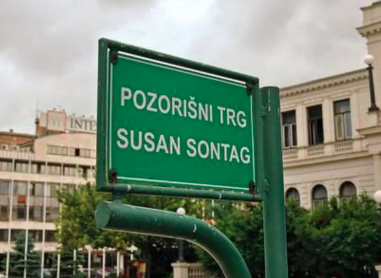
—
Vil du læse mere?
3. kapitel fra “The Influence of the Nation-State on Art – The Case of the Former Yugoslavian Countries (Final Project of the Master of Visual Art Administration at New York University) af Shinya Watanabe
III. Interpretation and Censorship
A. Interpretation and the Difficulty of Finding an Appropriate Venue
a. Susan Sontag’s production of Waiting for Godot – for the citizen in Sarajevo?
b. Her sympathy toward Bosnian Muslims
c. Sontag’s Theory about NATO’s Intervention
d. Position of Sontag after the Kosovo War
e. The Changing Role of KLA: from Terrorist Group to Freedom Fighters
f. The Rambouillet Peace Treaty – Corruption of European Politics
g. Intellectuals against the Intervention of NATO
h. The Reputation of Sontag -Inside and Outside of the Nation –
i. Prize for Sontag and the Relationship of the Nation-States
og
“The Future of Europe: Susan Sontag’s Sarajevo Publication, Papers, and Production of Waiting for Godot.” (Interventions: International Journal of Postcolonial Studies) af Kristine Kotecki
Fra indledningen:
“A well-connected public intellectual who took up the cause of ending the siege of Sarajevo in the early 1990s, Susan Sontag helped to assemble an international community advocating North Atlantic Treaty Organization (NATO) intervention. The attention that she generated during her staging of Samuel Beckett’s Waiting for Godot turned her into the promotional face for what became a cause célèbre, and she continued to participate in many projects for Bosnia-Herzegovina after the play. In her Publications, Sontag championed Sarajevo as an exceptionally European cause bacause of tis liberal multicultural pluralism, in contradistinction to the rural, religious and militant periphery.”
og
“Venskabet mellem Giacometti og Beckett“, som bl.a. førte til det ikoniske træ fra den første produktion af “Venter på Godot”.
